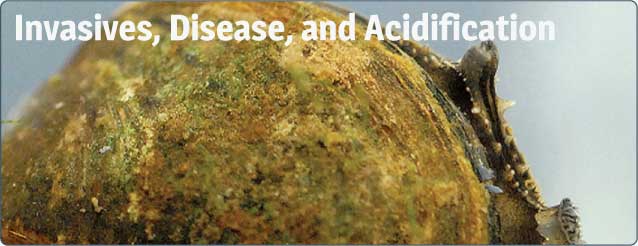
Photo Credit: NOAA, National Oceanic and Atmospheric Administration
The Great Migration
Plants and animals are “programmed” to avoid areas that have living conditions that don’t suit their biological needs. Not enough sun? A tree may compensate by growing tall and spindly to get above the forest canopy. This could increase its vulnerability to storm events and decrease its resistance to pests and diseases. A strong, healthy tree is more likely to adapt to the stresses of climate change making them better able to sequester carbon.
One of the largest factors that restricts where plants and animals live is temperature, specifically cold temperatures. If a fish swims north and suddenly finds the water temperature to be too cold, he can’t just put on a nice NorthFace fleece and carry on; instead he turns around and “fin-tails” it back to warmer waters.
But now, water and air temperatures are warming and plants and animals are taking advantage of that by moving north into uncharted territories. Narragansett Bay has warmed by over 3.5 degrees in the last 50 years while the air temperature has gone up almost 2 degrees since 1905. Those may seem like small numbers, but it is a big change for the environment, a change that has made the habitat real estate inviting to new species. Enter invasives!
Spoiling for A Bite
We keep certain foods in the refrigerator and freezer for a reason – to keep them from growing mold or spoiling. This keeps them at a temperature that slows down, or stops, the growth of mold and bacteria that can lead to food poisoning. Leave that food out on the kitchen counter in warmer temperatures and you are inviting bacteria to make your dinner home.

Long lines at the clam shack. Photo Credit: Save the Bay
The same thing happens with diseases in warming ocean waters. As the water heats up, diseases may become more prevalent or even expand into new waters. Just a few degrees can result in a disease running rampant.
New England is known for its excellent seafood. Lobsters, oysters, clams, and all varieties of fish are sold dockside, fresh from the fisherman’s trap, and grace the menus of restaurants ranging from clam shacks to high-end eateries. But the spread of emerging diseases due to climate change could mean that the seafood feast you enjoy as an Ocean State tradition may become more and more expensive as healthy animals are harder and harder to find. Not to mention the impacts to the food web as critters eat their way up the chain of ocean life. See the trend yet that all things are connected?
Clawing My Way to the Pot
Let’s talk lobsters. Once so abundant and cheap they were considered poor people’s food, these icons of New England now carry a hefty price tag and fed our heads of state at President Obama’s 2013 inauguration luncheon. However, in the last 20 years, lobster shell disease has popped up off the coast of Rhode Island and today a third of all lobsters have this disease. And the disease continues to march north – lobster shell disease has now been spotted off the coast of Maine. While warming waters may not be the sole factor in this epidemic, it has been shown to stress out
Want some seafood Mama
Steamers and sauce and then of course
I like oysters lobsters too
-Fats Waller the lobsters and make them more susceptible to disease and infection.
Oysters are also in the crosshairs of a disease triple threat: Dermo (a parasite that affects the shells of adult oysters), MSX (a second parasite that can strike faster than Dermo),and Juvenile Oyster Disease (a bacteria that can decimate entire oyster farms). All three of these gleefully spread in warm water. Does this spell the end to oysters and the $2 million economy they support in Rhode Island? Not if researchers and shellfish farmers have anything to say about it. They are dedicated to keeping oysters healthy in the water — and on your plate.
When Antacids Aren’t Enough
The acidification of the world’s oceans seems as charming a concept as drinking some toxic brew with smoke emanating from it that you see in a horror movie. But it is a very real aspect of climate change, and just about as appealing as that fuming beaker full of an unknown liquid.
In brief, the acidification of ocean water makes it difficult for marine animals with shells or skeletons to have them form properly or with adequate strength. One scientist jokingly suggested that it could result in future oyster bar menus offering choices along the lines of “clams on the no-shell.” Not very appealing at all.
by Arthur Mead, Jr.

Clams on the “No” Shell - Ocean acidification brought on by climate changes dissolves the shells of clams and oysters, as well as lobsters and crabs.
Understanding Ocean Acidification
Any marine animals that have shells or skeletons made of calcium carbonate (such as corals, quahogs, slipper shell snails, and sea stars) may be impacted by increased greater reductions in pH levels (lower pH = increased acidity).
Increased acidity lessens the ability of animals to build shells and skeletons, making it harder for them to form their natural protective shields. It can also impact the metabolism of marine organisms, such as water column-dwelling (pelagic) fishes and squid, by affecting their ability to breathe and reproduce.
More on Invasives, Diseases, and Acidification (Adobe Acrobat)
More on the Impacts of Acidification on Squid (Adobe Acrobat)
The Invasives are Coming! The Invasives are Coming!
- Hemlock Woolly Adelgid: Have you been out hiking and noticed that the hemlock trees don’t look so healthy. Upon closer inspection you see white woolly cotton balls on the twigs? These are a sign of hemlock woolly adelgid that are capable of killing trees in four years. The adelgid populations used to be controlled by cold winter temperatures, but now that temperatures are increasing, these invasives can spread more rapidly and kill more trees.
- Water Hyacinth: These large, freshwater plants were intentionally introduced to North America as an ornamental garden plant — they are pretty! However, they escaped the captivity of carefully manicured lawn ponds and are now found in Southern Rhode Island. Typically, water hyacinth does not survive freezing temperatures but it appears to be adapting and surviving mild winters that are becoming more and more common in southern New England. These plants form thick mats that can reduce light and oxygen for other animals that live below them, create a nightmare for boaters and swimmers, and — to add insult to injury — are a prime habitat for mosquitoes.
- Lionfish: Three decades ago, if you wanted to see lionfish you had to travel to a coral reef. Now, if you take a dive off the Rhode Island coast there is a chance you could see one. Cold waters previously kept their numbers in check but warming temperatures have led them into South Florida and up the eastern seaboard. Here in the Ocean State, they have no natural enemies and a high reproduction rate. Well, maybe one natural enemy — lionfish filets, anyone?
- Swarms of Insect Pests: Moses may not be standing before Pharaoh insisting his people be let go, but the swarms of insects are coming all the same. Hundreds of crop pests move north approximately two miles every year. Why? You guessed it — rising temperatures allow them to survive where previously it would have been too cold. Not only will these insects buzz around your head and create a rise in business at local carwashes, but they have serious implications for the agricultural industry and food security.
“There is sometimes quarrel and debate about complex modeling of climate and atmospheric projections, but evidence of ocean acidification is simple to measure and understand. Indeed, even the small noisy chorus of climate change deniers and corporate polluters is noticeably quiet on the issue of ocean acidification because they simply cannot explain away the facts.
– U.S. Senator Sheldon Whitehouse
News
“Tourists Are Flocking to Locations Threatened by Climate Change. That Only Makes Things Worse.” Vox
Factoids
Warming water and earlier spring seasons have resulted in a pole-ward migration of marine species.
The ocean absorbs about 30 percent of the carbon dioxide that is released in the atmosphere, and as levels of atmospheric carbon dioxide increase, so do the levels in the ocean.
Some diseases that affect aquatic life are likely to become more prevalent in warm water. For example, southern New England lobster catches have been declining significantly because of a temperature-sensitive bacterial shell disease that has been severely impacting the region’s lobster population.




